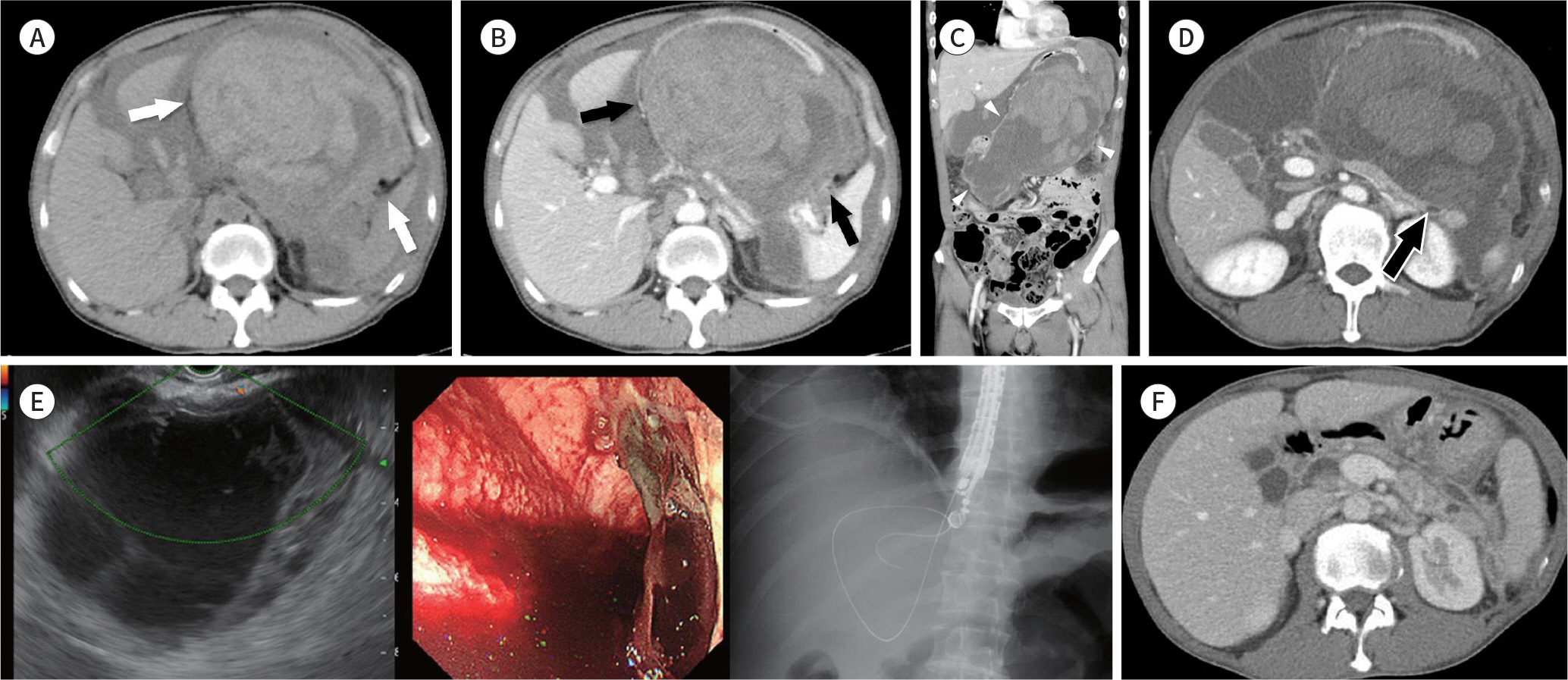J Korean Soc Radiol.
2019 Jan;80(1):117-121. 10.3348/jksr.2019.80.1.117.
Intramural Gastric Hematoma after Acute Necrotizing Pancreatitis: A Case Report and Review of Imaging Findings
- Affiliations
-
- 1Department of Radiology, Gil Medical Center, Gachon University College of Medicine, Incheon, Korea. nnoleeter@naver.com
- 2Department of Internal medicine, Gil Medical Center, Gachon University College of Medicine, Incheon, Korea.
- KMID: 2442470
- DOI: http://doi.org/10.3348/jksr.2019.80.1.117
Abstract
- Intramural hematoma of the gastrointestinal tract is a rare disease entity. Pancreatitis-induced intramural gastric hematoma (IGH) is far more seldom reported. Here, we report a rare case of a giant IGH occurring as a delayed complication of pancreatitis in a 51-year-old man. The diagnosis was made using computed tomography (CT) and endoscopic ultrasonography. The patient was conservatively managed, and follow-up abdominal CT showed marked decreases in the size of the IGH.
MeSH Terms
Figure
Reference
-
References
1. Imaizumi H, Mitsuhashi T, Hirata M, Aizaki T, Nishimaki H, Soma K, et al. A giant intramural gastric hematoma successfully treated by transcatheter arterial embolization. Intern Med. 2000; 39:231–234.
Article2. Dhawan V, Mohamed A, Fedorak RN. Gastric intramural hematoma: a case report and literature review. Can J Gastroenterol. 2009; 23:19–22.
Article3. Cimavilla Román M, Torres Yuste R, Vallecillo Sande MA. Intramural gastric hematoma in the context of an acute pancreatitis. Rev Esp Enferm Dig. 2017; 109:170.
Article4. Chou CT, Chen RC, Yang AD. Gastric subserosal hematoma developing from focal pancreatitis: a case report. Kaohsiung J Med Sci. 2009; 25:45–48.
Article5. Bailey WC, Akers DR. Traumatic intramural hematoma of the duodenum in children. A report of five cases. Am J Surg. 1965; 110:695–703.6. Fielding GA, McLatchie GR, Wilson C, Imrie CW, Carter DC. Acute pancreatitis and pancreatic fistula formation. Br J Surg. 1989; 76:1126–1128.
Article7. van Spreeuwel JP, van Gorp LH, Bast TJ, Nadorp JH. Intramural hematoma of the duodenum in a patient with chronic pancreatitis. Endoscopy. 1981; 13:246–248.
Article8. Ma JK, Ng KK, Poon RT, Fan ST. Pancreatic-induced intramural duodenal haematoma. Asian J Surg. 2008; 31:83–86.
Article
- Full Text Links
- Actions
-
Cited
- CITED
-
- Close
- Share
- Similar articles
-
- Successful Endoscopic Decompression for Intramural Duodenal Hematoma with Gastric Outlet Obstruction Complicating Acute Pancreatitis
- Intramural Duodenal Hematoma after Transpancreatic Septotomy during ERCP: A Case Report and Literature Review
- Acute Pancreatitis and Gastroduodenal Intussusception Induced by an Underlying Gastric Gastrointestinal Stromal Tumor: A Case Report
- Intramural Duodenal Hematoma Caused by Acute Gallstone Pancreatitis
- A Case of Duodenal Intramural Hematoma Caused by Acute Alcoholic Pancreatitis


